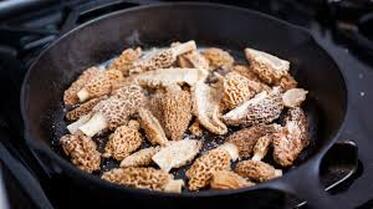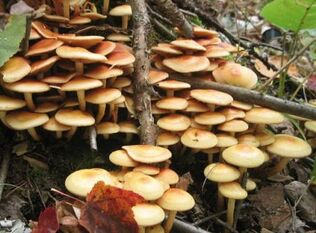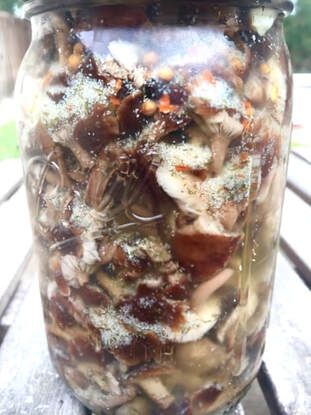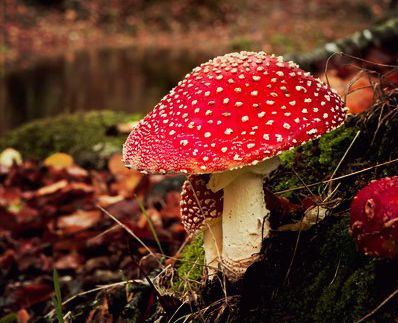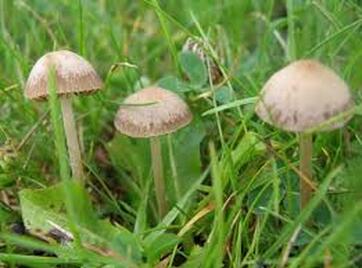"When in Doubt, throw it out."
Morels
What do Morels look like?
When do Morels Grow?
Where can you find Morels?
|
Natural Morels: grow in open fields, along roadsides and orchards. These Morels may appear consecutively for years only to disappear without any obvious reason. Natural Morels tend to like taking up residency at the base of dead and rotting trees.
Fire Morels: will often appear the spring following the previous summer’s forest fire. Fire morels like pine, and spruce, but if you are in a burn, look on the outer edge, or for patches where the trees are not charred. They like where the needle bed is reddish and are often in between tree roots or the shade of fallen timber. |
How to Harvest Morels
|
Collecting: using a sharp knife, it is best to cut a Morel about an inch from the steam. If you simply pluck the mushrooms the morel will become bruised, dirty and frayed.
Carrying: it is best to use a basket to both avoid squishing your bounty and to allow the mushrooms to breath. Storing: if refrigerated (and depending on condition when found) morels can typically last for about a week. How to Best Prepare MorelsMorels have a unique earthy and nutty flavor with an almost meaty texture.
Morels can be both eaten fresh, right after harvest, or dried for later use within the year. A common way of preparing morels is to simply cook the mushrooms in butter or olive oil helping to bring out their naturally nutty and earthy flavors. However, morels can be prepared extensively and a popular favourite is to batter and then deep-fry the mushrooms. Chanterelles
What do chanterelles look like?Chanterelles range in colour from a soft yellow to deep orange making them easy to spot along a forested floor. They can range in size from 2-5 inches in diameter with a wavy and funnel shaped cap.
Chanterelles have false gills that appear as forked and wavy wrinkles with blunt edges that run down the stem, the same color as the cap. Chanterelles also have a strong and distinct earthy, "mushroom" smell. When do chanterelles Grow?Chanterelles are a summer mushroom and tend to grow from mid July to early August depending on seasonal rainfall.
It is best to start looking for chanterelles after drenching rains followed by a few sweltering summer days. Where can you find chanterelles?Chanterelles tend to favour mossy and forested areas surrounded by birch.
Sometimes the best place to look for chanterelles is near streams and other low lying damp areas. Chanterelles tend to grow in the path off runoff or drainage where running water can carry their spores down hill. how to harvest chanterellesCutting: use a knife and make sure to leave the base near the soil intact, this will help ensure future harvests.
Carrying: of all the wild mushrooms chanterelles are the most delicate. Make sure to use a basket and be careful to not pile too many mushrooms on top of each other to prevent bruising and breakage. Storing: if refrigerated and stored in a paper bag (and depending on condition when found) chanterelles can typically last for about ten days. However, the flavour will start to deteriorate after two. how to best prepare chanterellesChanterelles are best eaten when fresh, and it is advised to only ingest these mushrooms after being cooked. However, chanterelles can be stored for long periods of time if boiled first and then frozen.
Chanterelles have a mild, nutty and sometimes peppery flavour making them very versatile in the kitchen. Chanterelles are best prepared simple, either sautéed in butter or used in cream sauces and served alongside chicken or egg dishes. |
Lobster mushrooms
What do lobster mushrooms look like?
|
Lobster mushrooms do not look like the typical stem-cap-gill mushrooms commonly found in the wild.
Lobsters are a special type of mushroom that get parisitized by another fungus, called Hypomyces causing them to change shape. Often these mushrooms tend to resemble lobster claws peeking out from the forest floor. Lobster mushrooms are dark red or orange in colour making them the easiest mushroom for amateur foragers to find. When do lobster mushrooms grow?Lobsters are a summer mushroom that typically grow in the months
of July and August. where can you find Lobster Mushrooms?Lobster mushrooms tend to grow alongside chanterelles. They prefer wooded and mossy areas with good irrigation, much like the chanterelles, and can be often found alongside pine and birch trees.
Something to also keep in mind is that Lobster mushrooms tend to prefer shaded areas and often grow beneath fallen leaves or remain partially covered by the moss or earth they are growing in. |
How to Harvest Lobster mushrooms
|
Collecting: do not use a knife to collect lobster mushrooms. Instead, simply pluck the mushroom from the earth and then use a knife to cut the mushroom open to check for bugs. Lobster mushrooms should be heavy like a paper weight and firm, if the mushroom feels light like Styrofoam, crumbles upon picking or is spongy to the touch that means they are too old to be harvested and are dangerous to ingest.
Carrying: lobster mushrooms are one of the sturdiest wild mushrooms and can be carried in anything. Storing: lobster mushrooms have the shortest shelf life in terms of wild mushrooms and should be used within two days of being picked. |
How to best prepare Lobster Mushrooms
|
Lobster mushrooms have both a unique aroma and taste that is reminiscent of shellfish.
They are best eaten fresh and do not freeze well. However, in terms of storage, lobster mushrooms can be pickled. Due to their robust taste, Lobsters are a good mushroom to be added into casseroles, other baked dishes and cream sauces. |
Honey Mushrooms
What do Honey Mushrooms LOOK like?
when do honey mushrooms grow?
Honey Mushrooms are a fall mushroom and can be found in from the months of August into September depending on nightly temperatures and frost dates.
Where can you find Honey Mushrooms?Honey Mushrooms are a type of parasitic mushroom that infects surrounding trees. In the Red Lake area Honeys tend to favor birch trees growing in clusters around the base of older trees.
Honeys also prefer to grow on dead or rotting hard wood trees. |
How to harvest Honey MushroomsCollecting: it's best to collect Honeys when the caps are smaller and crisp (these are the best for pickling). A knife is not needed, simply pluck the mushrooms at the base.
Storing: if refrigerated (and depending on condition when found) Honeys can typically last for about a week. |
How to best prepare Honey MushroomsHoney mushrooms can only be ingested when cooked thoroughly and are best prepared fresh.
Honeys have a nutty and sweet flavor that is best brought out after slowly roasting the mushrooms. By far, Honeys are the best mushrooms for use in pickling and freezing (as long as they are blanched first. |
"All mushrooms are edible, some only once in a lifetime."
POISONOUS MUSHROOMS
MUSHROOMS TO AVOID
Haymaker's Mushroom
Work Cited
Untamed Feast: Everything...About Morel Mushrooms
https://untamedfeast.com/morel-mushrooms/#:~:text=Morels%20are%20one%20of%20the%20few%20spring%20species%20of%20mushrooms,mid%20and%20occasionally%20late%20summer
Mushroom Appreciation: Honey Fungus
https://www.mushroom-appreciation.com/honey-fungus.html#sthash.vEBJPVlg.e3vRRqts.dpbs
Forager Chief: The Hills Have Lobster Mushrooms
https://foragerchef.com/the-hills-have-lobster-mushrooms/
Forager Chief: Honey Mushrooms
https://foragerchef.com/honey-mushrooms-the-pride-of-eastern-europe/
Forbes Wild Foods: Learn About Chanterelle Mushrooms
https://wildfoods.ca/blog/chanterelles/
Wild Edibles: Chanterelle Mushrooms; By: Eric Orr
https://www.wildedible.com/foraging-chanterelles
Fields and Streams: Beginners Guide...Morel Mushrooms; By: Phil Bourjaily (2013)
https://www.fieldandstream.com/articles/hunting/2013/04/finding-cooking-morel-mushrooms/
https://untamedfeast.com/morel-mushrooms/#:~:text=Morels%20are%20one%20of%20the%20few%20spring%20species%20of%20mushrooms,mid%20and%20occasionally%20late%20summer
Mushroom Appreciation: Honey Fungus
https://www.mushroom-appreciation.com/honey-fungus.html#sthash.vEBJPVlg.e3vRRqts.dpbs
Forager Chief: The Hills Have Lobster Mushrooms
https://foragerchef.com/the-hills-have-lobster-mushrooms/
Forager Chief: Honey Mushrooms
https://foragerchef.com/honey-mushrooms-the-pride-of-eastern-europe/
Forbes Wild Foods: Learn About Chanterelle Mushrooms
https://wildfoods.ca/blog/chanterelles/
Wild Edibles: Chanterelle Mushrooms; By: Eric Orr
https://www.wildedible.com/foraging-chanterelles
Fields and Streams: Beginners Guide...Morel Mushrooms; By: Phil Bourjaily (2013)
https://www.fieldandstream.com/articles/hunting/2013/04/finding-cooking-morel-mushrooms/





